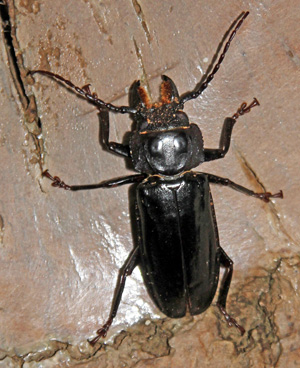
The beetles, order Coleoptera, constitute the single largest group of animals on earth. Approximately one quarter of all animal species known to science and a third of all described insects are beetles. There are almost 30,000 species known in the U.S. and Canada and roughly ten times that number in the world. With such great diversity, the beetles have a great number of different life styles. There are plant feeders, scavengers, fungus feeders, parasites of vertebrate animals, predators, and true parasitoids of other insects. Beetles occur in virtually all habitable terrestrial and freshwater environments. Within individual families of beetles there is generally some uniformity of life history. For example, almost all ground beetles are predaceous and the leaf beetles are mostly all leaf feeders. The life histories within some families are a bit more variable. For example, although the majority of members of the lady beetle family are predators, a few species (such as the pestiferous Mexican bean beetle) are plant feeders, and others are fungus feeders.
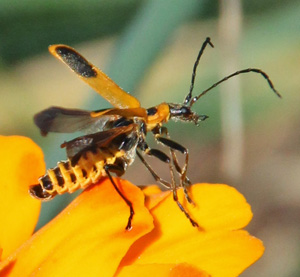
Coleoptera means “sheathed wing,” referring to the fact that the first pair of wings has been thickened into a pair of hard sheaths, or elytra, that cover the delicate hind wings. Beetles undergo complete metamorphosis, meaning that the life stages consist of egg, larva (several instars), pupa, and winged adult. The length of the life cycle varies from species to species; certain wood boring beetles and scarab beetles may take 2-5 years or more, whereas other beetles may have several generations each year. Some species have similar feeding habits as both larvae and adults, and may even live in the same environment; the aphidophagous (aphid-feeding) lady beetles are one example. In other groups, the larvae and adults do completely different things. For example, blister beetle larvae are parasitic on soil-dwelling insects but the adult beetles feed on plants.
Good Guys
Of the approximately 40 families of beetles that have members that prey on or parasitize other insects, two families, the lady beetles and ground beetles, are particularly important in gardens, home landscapes and agriculture. Three others, the rove beetles, fireflies and soldier beetles, are commonly encountered in home gardens. Of the remaining families – which are not mentioned in this article – some are primarily aquatic, a few offer natural control of pests of agriculture or forestry, and others are not common.
Lady beetles – Family Coccinellidae
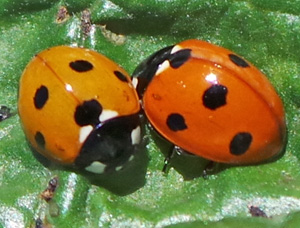
Lady beetles (more frequently, but less accurately, referred to as ladybugs; also called ladybird beetles) typically have round or oval, strongly convex bodies with bright contrasting colors. The elongate larvae are covered with tubercles or spines, and usually spotted or banded with bright colors. Most of the approximately 5,000 species worldwide (475 in North American) are beneficial predators, but a limited number are phytophagous (plant feeders) – the Mexican bean beetle (Epilachna varivestis) is the most notable.
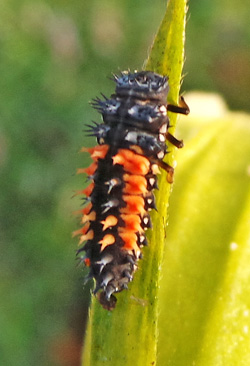
Most lady beetles overwinter in the adult stage and many form overwintering aggregations. Adults become active in spring when new plant growth has started and aphid colonies have begun to build. Eggs are laid near the prey. Many of the aphidophagous species lay clusters of 10-50 yellow to orange, oblong eggs. Females of aphidophagous species are capable of producing 500-1000 eggs each, over a period of one to two months. The eggs hatch in a few days, and the larvae begin feeding and continue to grow through the four instars. When the last larval stage is fully grown, pupation occurs, usually on a plant part, such as foliage or stem, where the larva was when it finished feeding. The pupal stage lasts about a week. The adults mate fairly soon after they emerge, and females begin laying eggs within about one week. On average, lady beetles require about a month to complete their life cycle. In warm tropical climates, lady beetles are active year-round. In the upper Midwest, there are generally 2-3 generations per year.
What About the Spots?
The color pattern can be diagnostic to determine the species of the lady beetle, as the number and pattern of spots can be quite consistent. The twospotted, sevenspotted, tenspotted, and thirteenspotted lady beetles are all distinct species. Some lady beetles have no spots, such as the tiny black spider mite predators of the genus Stethorus. Some, such as in the genus Chilocorus, have the spots reversed, red on a black background. Some species are more variable, such as the introduced multicolored Asian lady beetle, which may be unspotted, or have a variable number of spots.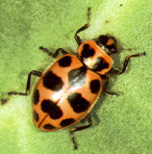
The common species of lady beetles – those that are larger, orange or red, often with black spots – are most frequently specialized predators of aphids. The number of aphids that can be consumed by a lady beetle varies somewhat with species of both predator and prey and also with environmental conditions such as temperature. But on average, fourth instar larvae (the last and largest larval stage) consume about 50 aphids per day, a number very similar to that consumed by the adult beetles. The species of lady beetles that are aphid predators will occasionally take other types of insects and mites as food.

However, the adults generally lay their eggs only where there are large numbers of preferred prey (aphids) available for their offspring. Therefore, many of these lady beetle species are better at reducing large numbers of aphids that may already be causing plant damage, rather than keeping small aphid populations from getting larger. Adult lady beetles may require other food in addition to prey, and many feed on flower pollen, nectar, or honeydew.

In addition to the aphid predators, there are other species that specialize on other types of prey. For example, Cryptolaemus is a mealybug predator; members of the genus Chilocorus are scale predators; and Stethorus species are predators of spider mites.
Ground beetles – Family Carabidae
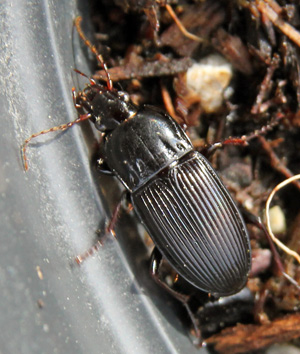
Ground beetles belong to the family Carabidae, which is one of the largest beetle families, with at least 34,000 and maybe more than 40,000 species worldwide. They are generally small to large (1/4 – 1 inch or more long), and brown or black in color. As the name suggests, they are usually found associated with the soil, particularly in damp habitats. Most are nocturnal and during the daytime they can be found under plant debris, stones, logs, and in other hidden places. At night they come out to feed. During their foraging, many will climb onto plants to feed on prey such as aphids and caterpillars. Others feed primarily in or on the surface of soil and take a variety of types of prey that are encountered there. When disturbed, they run quickly but seldom fly.
Many ground beetles have a single generation per year, but some complete two or three generations annually, and others may live 2-5 years. Usually it is the adult stage that overwinters. The larvae are also predators, but most spend their larval lives in the soil or other protected locations. Although ground beetles are generalist predators, and are frequently abundant, they may not always provide good pest control. The adults of many species will also feed on plant material, including pollen, fungi, and decaying plants; a few species feed on seeds, while a few others are considered to be damaging to agricultural crops.
Rove beetles – Family Staphylinidae

This is a very large, diverse group with more than 29,000 species. They are mostly small to tiny, slender, and often black in color. The elytra (the first pair of wings in the beetles, which are hardened to cover and protect the beetle’s abdomen) are very short in the rove beetles, so that several abdominal segments are exposed. Many species are nocturnal, and many are found associated with the ground, such as under leaf litter or stones, or in loose soil. Some rove beetles apparently are scavengers, but many are general predators, in both the adult and larval stages. Some have been shown to be important natural enemies of the eggs and larvae of flies that breed in manure or similar habitats. Some types occur in vegetation where they prey on plant pests.
Fireflies – Family Lampyridae
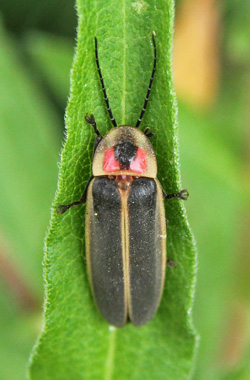
Adult fireflies are medium-sized, dark-colored beetles with soft and flexible elytra. They rest on foliage during the day and fly at night. The nocturnal larvae of the familiar “lightening bugs” feed chiefly on snails and slugs; other prey of this family includes earthworms, cutworms, leaf beetle larvae and various other soft-bodied insects. Luminescent larvae are often called “glow-worms,” a name also used for larvae of another family, the Phengodidae. The adults use their flashing lights in the mating process. Over 2,000 species have been described, with 125 in North America. The larvae prefer damp places and are inactive by day. Mollusk feeders live in moist habitats. Other species are found under debris on the ground, beneath bark, stones or decayed vegetation where considerable moisture exists.
Soldier beetles – Family Cantharidae
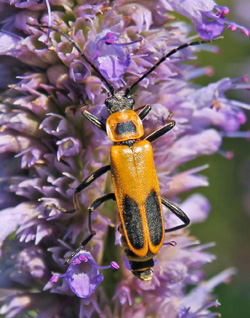
Adult soldier beetles are elongate, soft-bodied beetles similar to fireflies. They are usually found on flowers, and some species have been observed feeding on aphids and other soft-bodied insects. The larvae of most species are predaceous on other insects, including eggs of grasshoppers, small caterpillars, maggots and other soft-bodied insects. Some are omnivorous, feeding to some extent on plant tissue such as wheat grains and vegetables. Some 4,500 species are known in the world with 468 in North America. A common species in the Midwest is the goldenrod soldier beetle.
Bad Guys
Most gardeners are more aware of the plant feeding (phytophagous) beetles than the predatory types. There are numerous beetle families that are primarily phytophagous. Many of these are found in forests, aquatic habitats, or in decaying vegetation. The four most important families of beetles with common garden pests and two additional families that have some significant pests of ornamental plants are reviewed here.
Leaf beetles – Family Chrysomelidae
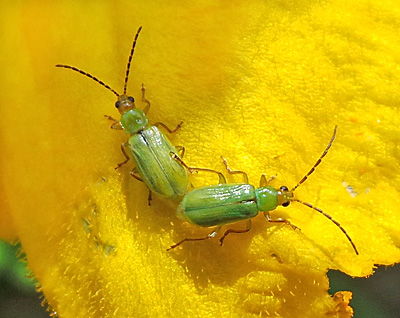
This is an abundant group with about 35,000 species worldwide and 1,500 in North America. The adults are oval to oval-elongate in shape, but vary a lot in color and shape so they can be difficult to recognize consistently.
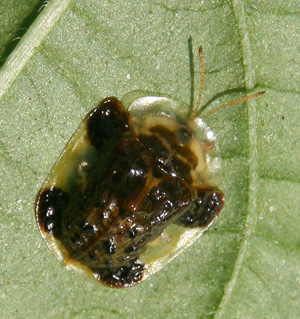
Both the adults and larvae are plant feeders. Adults typically feed on flowers and foliage. When numerous, they remove a lot of leaf tissue and can cause significant damage to the plants. Although some larvae also feed on leaves, many larvae attack plant roots.
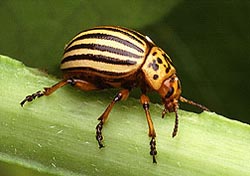
This group includes many serious garden and agricultural pests including asparagus beetles (Crioceris spp.), bean leaf beetle (Cerotoma trifurcata), Colorado potato beetle (Leptinotarsa decemlineata),
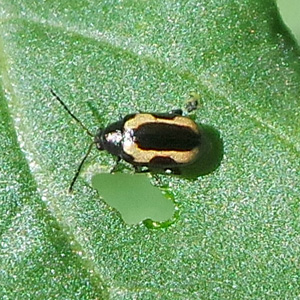
corn rootworms (Diabrotica spp.), cucumber beetles (Diabrotica undecimpunctata howardii and Acalymma vittata), elm leaf beetle (Pyrralta luteola) and numerous types of flea beetles. The flea beetles have hind legs modified for jumping, so they scatter quickly when disturbed. The adults chew round shotholes in foliage; the larvae feed on plant roots.
Scarab beetles – Family Scarabaeidae
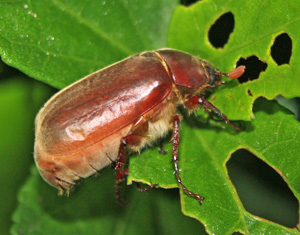
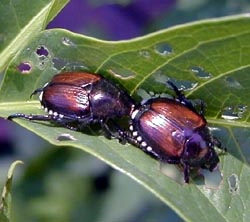
Scarab beetles, including dung beetles, chafers and others, are oval or elongate and convex with heavy bodies. Both the adults and larvae feed on plant material. Some of the 16,500 species worldwide feed on decaying organic matter while others prefer living plants. The most significant scarab pests in gardens are the chafers or white grubs.
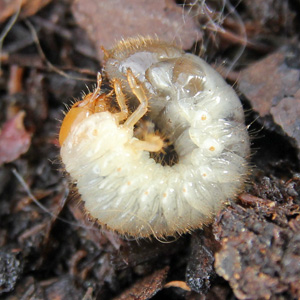
The light-colored, grub-like larvae live in the soil, feeding on roots of grasses and other plants for one or more years. They often are pests of lawns and some root crops. The adults emerge to feed on the foliage of a variety of ornamental plants. Some common scarabs include Japanese beetle (Popillia japonica), rose chafer (Macrodactylus subspinosus), June beetles (“Junebugs”), May beetles, and others.
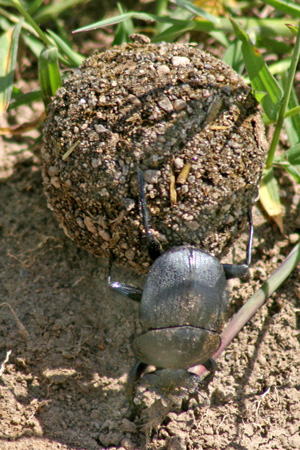
The dung beetles lay their eggs in underground chambers that the adults supplied with dung of grazing animals, where the larvae feed and pupate, emerging as adults. Some dung beetles form balls of dung that they roll about with their hind legs, sometimes for long distances and sometimes working in pairs. Eventually, they bury the ball and lay eggs in it. These scarabs play a very important role in the rapid recycling of organic matter and the disposal of disease-breeding wastes.
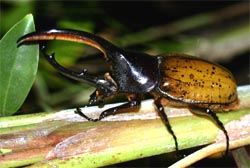
Some scarab beetles can attain incredible sizes. In the tropics, the prominently-horned Hercules beetles, rhinoceros beetles and elephant beetles may be as big as 6” (including the horns); their biggest North American relatives generally are only up to 2½” long. Despite their intimidating appearance, these beetles are harmless to people.
Weevils – Family Curculionidae
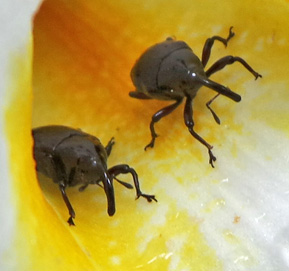
The largest of beetle families, with about 48,000 species worldwide, is comprised almost entirely of plant feeders, either on plants or stored grains. They are easily recognized by their elongated snout and elbowed antennae on the snout. The beetles’ mouthparts are on the end of the snout, which they use to drill holes in fruits or seeds. When disturbed, the adults tuck their legs in and drop to the ground.
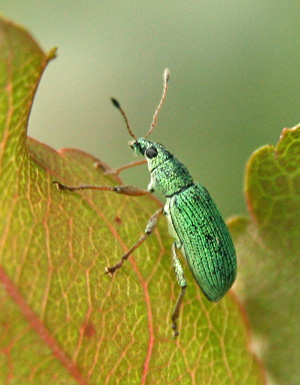
The boll weevil (Anthonomus grandis) may well be the most infamous member of this family in the United States. Plum curculio (Conotrachelus nenuphar) is an important weevil pest of tree fruit crops.
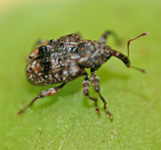
The black vine weevil (Otiorhynchus sulcatus) and strawberry root weevil (Otiorhynchus ovatus) are common pests in gardens, with the larvae feeding on the roots of many woody shrubs and strawberry. The adults also feed on foliage, producing characteristic notches along leaf margins, that is often mistaken for grasshopper feeding. Euonymous is one of the plants frequently damaged by adult root weevils. The strawberry clipper (Anthonomus signatus) damages strawberries by puncturing unopened buds to deposit an egg inside. The female then cuts the strawberry bud off, preventing fruit formation.
Click beetles – Family Elateridae

Click beetles get their name from the adult’s method of righting themselves. When on their back, these beetles can snap two parts of the body together, spring up into the air, and land on their feet. The adults are slender, shiny and hard-bodied and are found on leaves and flowers.
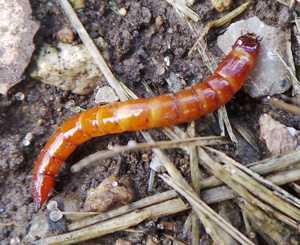
The larvae, called wireworms, live in the soil, decaying vegetation, under bark and other situations where they are not exposed to light. There are many destructive species that feed on seeds and roots, and many others are scavengers. However, many species are predaceous, feeding on insects and other invertebrates. In the home garden, wireworms cause problems primarily in new vegetable gardens that were formerly lawns. The larvae, deprived of their normal food of grass roots, turn to any available plants to feed on and cause damage especially to root crops such as radishes, potatoes and carrots.
Long-horned beetles – Family Cerambycidae
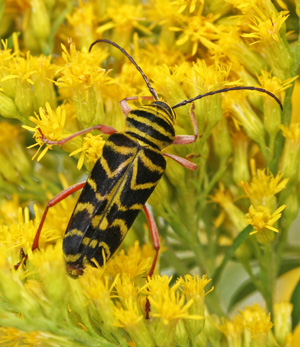
These beetles get their common name from their distinctive antennae which are at least ½ the length of the body and sometimes even longer than the body. They tend to be elongate and cylindrical in shape, and often are brightly colored. The colorful species are active during the day, while the dark ones are nocturnal. Many of the 30,000 species worldwide are quite large.
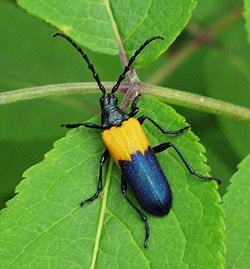
Adults typically feed on flowers. The long, white larvae bore into the stems of herbaceous plants or trees, and can be very destructive to trees – the introduced Asian

longhorned beetle (Anoplophora glabripennis) is a good example. Other cerambycids that may be encountered in the garden include the red milkweed beetle (Tetraopes tetrophthalmus) on common milkweed (Asclepias syriaca) and the brightly colored blue and yellow elderberry borer (Desmocerus palliatus).
Metallic wood-boring beetles – Family Buprestidae
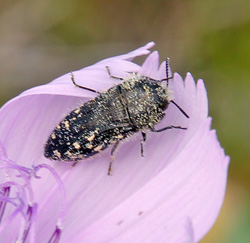
Most species in this diverse group of beetles, sometimes called jewel beetles, are fairly large, usually shiny, and sometimes very colorful. Most have a bullet-shaped, very hard body. The adults feed on foliage and the larvae, called flat-headed borers, tunnel in wood. Many species are important forest pests. Some common buprestid pests of ornamentals include bronze birch borer (Agrilus anxius) and chestnut borer (Agrilus bilineatus, which causes significant problems in oak trees in the Midwest. There is a smaller species that attack raspberries. The emerald ash borer (Agrilus planipennis) is an Asian buprestid that was accidentally introduced in the Midwest and threatens ash trees in infested areas.
– Susan and Dan Mahr, University of Wisconsin – Madison





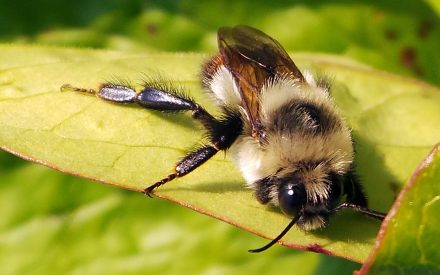 Join in Community Science with the Wisconsin Wild Bee App
Join in Community Science with the Wisconsin Wild Bee App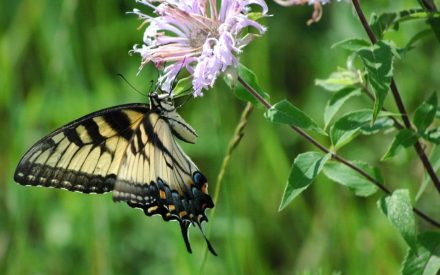 How do Pesticides Affect Pollinators and Songbirds in Your Yard
How do Pesticides Affect Pollinators and Songbirds in Your Yard Pollinator Gardens: Plant Selection and Garden Care
Pollinator Gardens: Plant Selection and Garden Care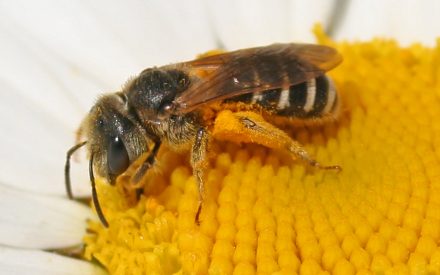 Wisconsin’s Busy Bees: Getting to Know the Bees in Your Area
Wisconsin’s Busy Bees: Getting to Know the Bees in Your Area


